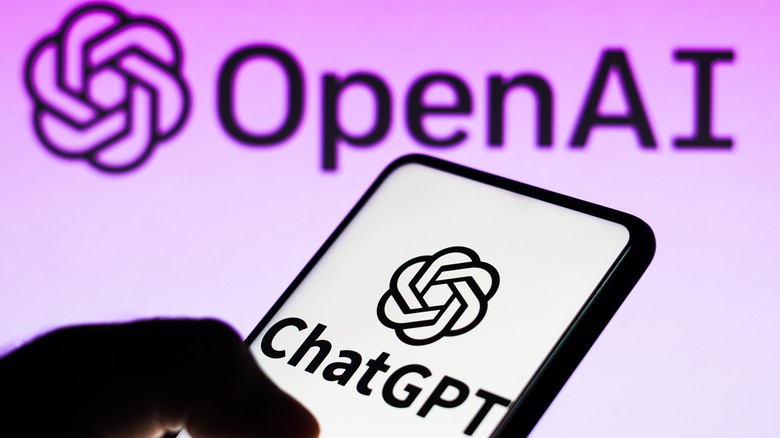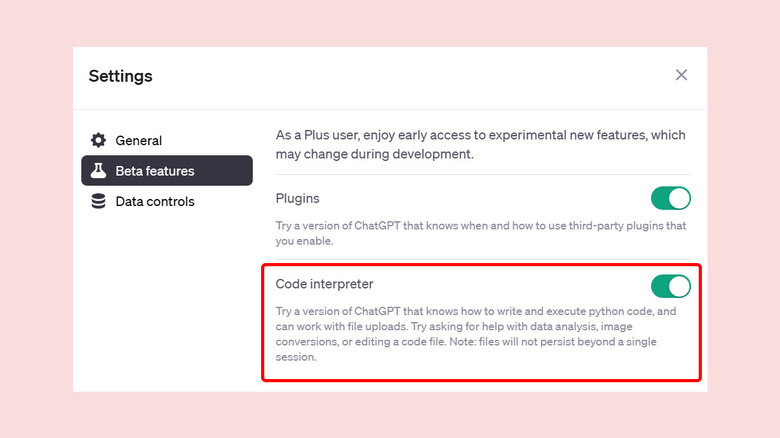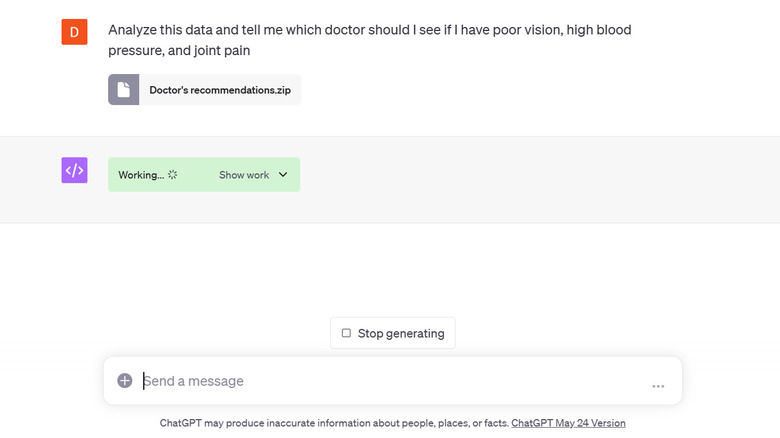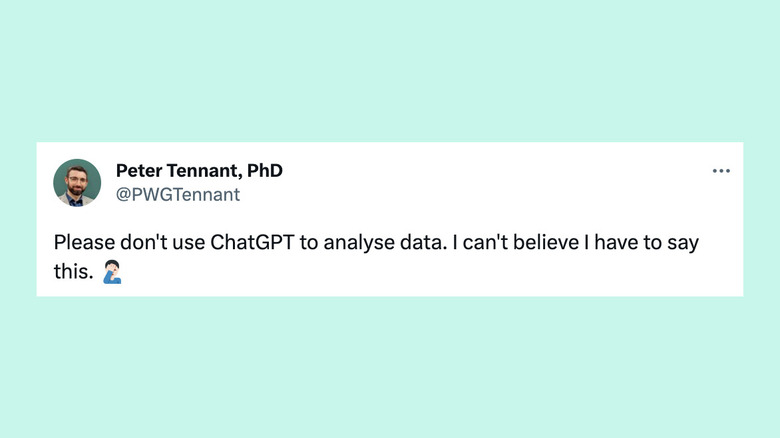ChatGPT's New AI Feature Lets You Upload Files, Create Charts, And More
Generative AI tools such as ChatGPT have brought about a massive technological shift, especially with the ability to perform complex tasks based on simple, colloquial instructions. The features are about to get even more advanced with ChatGPT's creator OpenAI unleashing a new powerful add-on called Code Interpreter, which can perform complex functions in a matter of seconds.
Code Interpreter is part of ChatGPT's paid tier — called ChatGPT Plus — which comes at a premium of $20 a month. ChatGPT Plus is based on the newer GPT-4 AI model, trained on a more extensive data set, and is, therefore, more accurate and has fewer incorrect responses or hallucinations.
If you're part of the paid tier, you can access upcoming features such as plug-ins, which let you interact with third-party applications. Likewise, Code Interpreter, which has recently moved from alpha to beta phase, is open for all ChatGPT Plus subscribers to try. Contrary to its naming, the feature does not merely interpret code; it does a lot more, from writing code to analyzing data, creating visual representations, and solving complex math problems. Although the real advantage here is for data analysts, the new tool can handle common types of files and perform multiple functions.
Here's everything you should know about ChatGPT's Code Interpreter.
What is ChatGPT's new Code Interpreter?
ChatGPT's new Code Interpreter can read and interpret data from large sets, perform a myriad of analyses, and present its final form using figures or graphs. It can also merge data with other forms of media to show images, GIFs, or animated graphs.
Code Interpreter fundamentally differs from the AI chatbots such as ChatGPT, Microsoft Bing AI, and Google Bard. That is because these chatbots rely on something known as a Large Language Model or LLM, which is a machine learning model that predicts answers by outputting one word at a time. In comparison, Code Interpreter is a coding environment that responds to user queries by writing task-specific codes in the Python programming language.
While ChatGPT itself is capable of writing code, you must run and debug the code manually. Code Interpreter, on the other hand, can not only write Python code but also run it within the ChatGPT interface. Since Code Interpreter manages tasks by writing Python code instead of relying on an LLM, it improves the accuracy of results and is expected to have fewer hallucinations. This is because the results are obtained from impromptu reasoning instead of textual data from written sources — including books, articles, and websites on the internet.
Here's how to use ChatGPT's Code Interpreter
Before talking about Code Interpreter in detail, here are the steps you must follow to start using it:
- Log on to ChatGPT and sign up with an existing account or create a new one.
- If you are currently a free ChatGPT user, you must upgrade to a ChatGPT Plus account. To do that, click the "Upgrade to Plus" option at the bottom left corner of the ChatGPT interface.
- Click "Upgrade Plan," and proceed with the payment and return to the ChatGPT interface.
- Click on three dots next to your name in the bottom left corner and click "Settings."
- Click "Beta features" on the left side of the window that pops up.
- Enable Code Interpreter using the toggle next to its description.
- Now go back to the main ChatGPT interface and choose GPT-4 as the model instead of GPT-3.5.
- You will see a drop-down menu when you select GPT-4. Open it and select Code Interpreter instead of Default.
- You will now see a "+" icon to upload files and perform a breadth of tasks.
Although you must currently be a part of ChatGPT's paid tier to access Code Interpreter, the feature may also come to Microsoft's Bing Chat AI over the coming months. In addition to the fact that Bing Chat already runs on GPT-4, our assumption is based on Microsoft's recent promise to bring support for file uploads to its chatbot.
What can the Code Interpreter do?
Code Interpreter can accomplish a lot with large data sets, including predictive and network analysis, cleaning and restructuring, and drawing conclusions based on data. It can answer specific questions about the data, backed by a logical reason, and even tweak the approach based on simple instructions. Then, it can create 2D or 3D charts to represent that data, creating maps, and even animated graphics based on the data.
This was kind of delightful: I uploaded a CSV file of every lighthouse location in the US.
"ChatGPT Code Interpreter: Create a gif of a map of the lighthouse locations, where the map is very dark but each lighthouse twinkles." A couple seconds later... pic.twitter.com/f14JLWQCyB
— Ethan Mollick (@emollick) May 2, 2023
Besides analyzing and visualizing data, Code Interpreter lets you copy the Python code so it can be run in a local environment. It also can be used to create downloadable data dashboards and for a variety of other purposes that can be accomplished by writing Python code. Computer scientist Gavriel Cohen notes the tool currently supports over 300 Python packages and libraries.
You can simply add files that need to be processed into Code Interpreter and write down the instructions in the chat bar. It currently supports text documents, PDF files, images, videos, audio files, and HTML pages. It can also parse databases compiled in Microsoft Excel (or its free replacements), SQLite, and CVS files and access code written in Python, Java, JavaScript, C++, etc.
While OpenAI does not specify the maximum file size you can upload in Code Interpreter, researcher Ethan Mollic notes in their blog that the maximum supported file size is 100MB, but you can also upload compressed files in a ZIP format.
Concerns with Code Interpreter
In theory, Code Interpreter is an incredibly powerful tool that can take care of what could otherwise be considered time-consuming grunt work. As Mollic remarks, it exhibits skills to complete tasks in seconds that they took a long time to master during their Ph.D. The researcher adds they feel hopeful AI will not replace humans but will rid us of "annoying, repetitive parts of our job so we can focus on the good stuff."
Despite its abilities, certain academics, including University of Leeds associate professor Peter Tennant, oppose the use of Code Interpreter for data analysis. Tennant believes relying on an algorithm for complex tasks that require human specialization and years of practice can lead to insufficient and unreliable results.
Good data analysis is tricky. It requires knowledge, training, & thought. That's not gatekeeping, it's a fact for most scientific tasks!
Machine learning tools may be tempting, but naive data-driven analyses can be dangerously misleading. We need more thought not less.
— Peter Tennant, PhD (@PWGTennant) July 9, 2023
Simultaneously, Code Interpreter is also prone to the same privacy concerns as ChatGPT — or AI in general. OpenAI has yet to update its privacy policy to clarify if it uses the data being uploaded to the tool to refine it. While testing Code Interpreter's capabilities with data from the open domain should not be an issue, researchers must be careful before inputting any confidential data.




